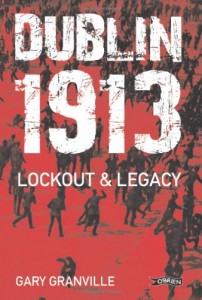Welcome re-release of 1913 book – Review by James Curry
By Gary Granville
The O’Brien Press
€9.99
http://www.obrien.ie/dublin-1913
Gary Granville’s Dublin 1913: Lockout & Legacy is an expanded edition of a book originally published in 1978 under the title Divided City: Portrait of Dublin 1913. While the new choice of title is easily understood considering the obvious desire of the publisher to capitalise on the current centenary year of the 1913 Dublin Lockout, it is the opinion of this reviewer that the original title was actually more appropriate.
For Granville’s book is not just an account of 1913, but rather a study of the great divisions that existed in Dublin society during the early 1900s: divisions which were then vividly highlighted during the epic industrial dispute. Furthermore, the wonderfully evocative range of photographs and other visual imagery utilised throughout effectively combine with Granville’s text to indeed offer a portrait of Dublin in 1913.
The fact that James Larkin does not appear on the scene until over halfway through the main narrative is indicative of the fact that Granville has compiled a multi-dimensional view of Dublin social history at the beginning of the twentieth century, rather than a labour history book focusing solely on the Lockout.
When it first appeared back in 1978, Divided City marked an important event in the emerging field of Irish labour history, a development discussed by Granville in a new closing chapter on the legacy of 1913. This interesting section explains how an event that was previously largely neglected in the writing and teaching of Irish history has since received more and more recognition, becoming ‘embedded in the consciousness of Dubliners, of Irish citizens and increasingly in the picture that Ireland in general and Dublin in particular, presents to the world’. A new introduction has also been added to the book, although the main text itself (a few different illustrations aside) has seemingly not been revised.
The book’s original release was the result of an innovative education project carried out by the Curriculum Development Unit, an educational body set up in Dublin six years earlier. The slim, attractively produced book proved extremely popular with many readers, and was ‘successfully used in education programmes in universities and schools, adult education classes and trade union study groups’ for many years afterwards, as Granville explains in his new introduction.
Incidentally, it is nice to see Granville’s name on the cover and title page of this new edition, rather than the cumbrous sounding “Curriculum Development Unit, Dublin” that was used back in 1978. Although a plethora of secondary schools helped in the ‘development, use and revision’ of material used in the book, and he received advice from a number of knowledgeable figures such as Mary Daly and the late Donal Nevin, it was Granville – now a Professor of Education in the National College of Art and Design – who ‘researched and edited’ the publication. The fact that he is now properly credited as the book’s author will come as a big relief to academics wishing to reference the book.
Historian Owen Dudley Edwards was so annoyed at the ‘peculiar anonymity’ of the original edition, that when reviewing the book for the Irish Times in the summer of 1978 he repeatedly referred to the author as “Mr C. D. Unit” in a mischievous attempt to emphasise how awkward it would be for any historians hoping to cite the book in their future research!
As fine a book as Dublin 1913 undoubtedly is, certain areas for improvement do exist. There are a few typos (most notably on page 153 where the book’s new sub-title is accidentally reversed to Legacy & Lockout), and a few factual errors (for example, William Martin Murphy and Jim Larkin were born in 1844 and 1874 respectively, not 1845 and 1876; Cork native Murphy did not hail from Bantry but from near Castletownbere; the meeting that launched the Irish Transport and General Workers’ Union (ITGWU) occurred in late December 1908 rather than early January 1909, which was instead when the ITGWU was formally registered as a trade union; George Askwith was a ‘Sir’ rather than a ‘Lord’ when attempting to negotiate a peace settlement during the early months of the Lockout; and it was Dora Montefiore rather than ‘some women’ who initially came up with the ill-fated “Save the Kiddies” scheme idea).
There are also a few disappointing omissions: the role of Delia Larkin and the Irish Women Workers’ Union in the Lockout is completely ignored, surprising for a book which specifically highlights how the position for Dublin women workers’ ‘was even worse’ than the men at the time; no images are taken from the Irish Worker, the ITGWU’s popular weekly newspaper of the time; while the efforts of important ITGWU figures like P. T. Daly and William P. Partridge are also essentially neglected. At times the book also provides an over-simplification of 1913 as essentially being a battle between Larkin and Murphy.
Yet there is no denying that Granville’s book is a fascinating and occasionally engaging effort, one that ably honours ‘the spirit and solidarity of thousands of ordinary people in a divided city, a hundred years ago’. Dublin 1913 offers readers a concise and lucid overview of the Lockout while intelligently placing the great dispute in its historical context.
Accessible and reader friendly, it is thus the perfect introduction for anybody wishing to learn about 1913 before they feel ready to tackle the likes of Pádraig Yeates epic Lockout: Dublin 1913 (recently re-released by Gill & MacMillan to mark the current centenary year) and Francis Devine’s recent edited collection of essays by a wide range of contributors, A Capital in Conflict: Dublin City and the 1913 Lockout (Dublin City Council).
Granville’s publication has long been something of a collector’s item in Irish labour history circles: its re-release in a reasonably priced revised edition is to be warmly welcomed. Hopefully Mr C. D. Unit’s intriguing little book will enjoy the same wide and appreciative readership which it received upon its initial release over three decades ago.
James Curry


